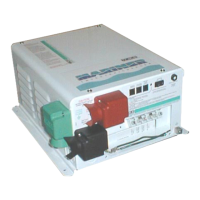,03257$176$)(7<,16758&7,216
&RS\ULJKW7UDFH(QJLQHHULQJ&R,QF 7HOHSKRQH 3DUW1XPEHU
WK
6WUHHW1( )D[ 2FWREHU
$UOLQJWRQ:$86$ ZZZWUDFHHQJLQHHULQJFRP
3DJH
7. No terminals or lugs are required for hook-up of the AC wiring. AC wiring must be no less than
10 AWG (5.3 mm
2
) copper wire and rated for 75
°
C or higher. Battery cables must be rated for
75
°
C or higher and should be no less than the minimum size wire recommended by this manual.
Crimped and sealed copper ring terminal lugs with a 5/16” hole should be used to connect the
battery cables to the DC terminals of the inverter/charger. Soldered and crimped cable lugs are
also acceptable. Solder shall not be the sole means of mechanical connection in any circuit
[ABYC E-9.16(k)] unless the solder contact length exceeds 1.5 times the diameter of the
conductor. See section
Batteries and Chargers
for correct battery cable size and length for your
application.
8. Torque all AC wiring connections to 15-20 inch-pounds. Torque all DC cable connections to 10-
12 foot-pounds.
9. CAUTION: To reduce the risk of fire, use only input circuits provided with the correct ampere
branch circuit protection in accordance with the National Electric Code, ANSI/ NFPA70
10. Use the correct tools to make AC/DC wiring connections: wire strippers, ½” (13mm) open-end
wrench or socket, Phillips screw driver #2, and ¼” flat blade screwdriver (6mm).
11. This inverter/charger should be used with a battery supply of 12-volts DC nominal voltage.
12. Do not install this inverter/charger on or near flammable materials (plywood, chemicals, gasoline,
etc.).
13. The unit is designed for mounting on a flat surface only. Do not mount on a bulkhead or hang
inverted.
14. No AC or DC disconnects are provided as an integral part of this inverter. Both AC and DC
disconnects must be provided as part of the system installation. See
Installation
section on Page
23 of this manual.
15. No overcurrent protection for the battery supply is provided as an integral part of this inverter.
Overcurrent protection of the battery cables must be provided as part of the system installation.
See
Installation
section of this manual.
16. No overcurrent protection for the AC output wiring is provided as an integral part of this inverter.
Over-current protection of the AC output wiring must be provided as part of the system
installation. See the
Installation
section of this manual.
17. DC GROUNDING INSTRUCTIONS - This inverter/charger should be connected to a grounded,
permanent wiring system. For most installations, the negative battery conductor should be
bonded to the vessel safety-grounding conductor (green wire) as per ABYC standard E-8.5 and
E-9.20. Connection of the green DC negative ground terminal on the side of the inverter to the
DC load center negative bus (connected in turn to the engine negative terminal) will create the
battery negative to vessel safety ground. All installations should comply with Federal
regulations.
Connect and disconnect DC output connections only after setting the inverter switches to the Off
position and removing AC shorepower cord from the shorepower connector, or after opening the
AC disconnect device.

